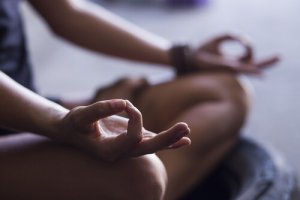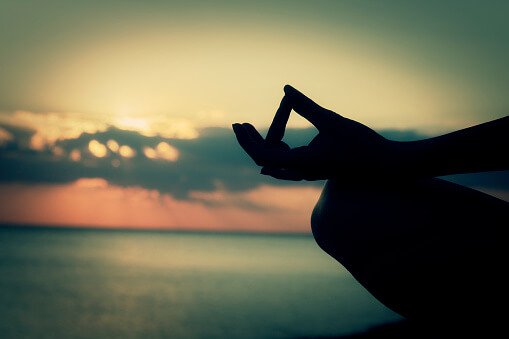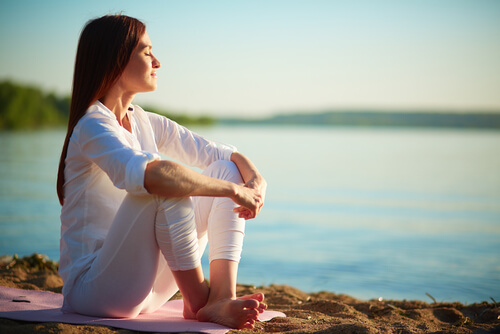Learn 4 Fundamental Steps to Start Meditating Now

Conscious attention, meditation, mindfulness, or Sati, as they call it in Pali, is a practice where we become aware of the different facets of our experience in the present.
To start meditating is to give ourselves the chance to get conscious of how we move, feel (physically and emotionally), and respond or react to situations.
This quality of awareness is the basis of all creative life. It allows us to be honest, pragmatic, awake, courageous, and active.
During so much of the day, we stop paying attention to what’s happening around us and dedicate the majority of our mental resources to working on our thoughts, whether they’re problems or positive things.
Some way or another, we turn on autopilot and disconnect. We get dressed, shower, or eat breakfast thinking about what we’ll do when we get to work. So, our work shift starts long before we sit down in front of our computer or pick up our tools.
How Can We Start Meditating?
To start meditating and reach a state of flow, where we’re fully concentrating on what’s happening now, inside and outside us, there are many different paths.
One of the most well-known and practiced methods is mindfulness. We can develop it through four basic steps:
- Full attention. It’s about centering our attention (without judging, defining, or interpreting) what happens around us at a specific moment. The sounds, the objects we see, what we feel, etc. Just observe.
- Connecting with our own thoughts and emotions. When we concentrate on what’s happening around us, emotions and thoughts will appear. We’ll let them flow, being aware of them and accepting them, nothing more.
- Living in the here and now. We live in the present by paying attention to it. By undertaking our day-to-day activities with full awareness.
- Developing compassion. Compassion starts with loving yourself. Then, applying this love to our loved ones and the rest of the world. Whether they’re just acquaintances or even enemies.

The technique of mindfulness is a process of preparation very similar to other kinds of meditation. This is true because all of them seek the same situation.
They seek an awakening of our attention and a state of bodily relaxation. If you’re interested, let’s move on to the central ideas of the process that will help us start meditating.
Body scan
The first idea is to relax our body. That way we can do conscious breathing and a technique called “body scan,” or body review. Body scan consists of exploring and taking note of our own body. It starts with our feet and then we review other areas.
We curiously observe the sensations we receive from each one of the areas where we focus our attention. The body scan can last between 5 and 20 minutes.
Once we’ve done this bodily sweep, we move to centering the meditative process in the present. We let the thing we need to work on enter our mind on its own. We’ll position ourselves as an observer.
Centering Yourself In the Now
We can achieve this focalization in the present through exercises of attention on an object (any object, just observing it). Also on sounds (listening to all the sounds we don’t perceive when we’re not in this state). Lastly, on physical sensations (what we can feel in our body), among others.
Avoiding Judgment and Interpretation
Attention to our mind and emotions from an observer’s perspective means receiving whatever our internal world wants to show us.
On this point, it’s about not interpreting or judging. Everything that happens inside us is normal and will teach us about ourselves.
These practices develop towards tonglen and metta. Tonglen and metta refer to compassion, towards ourselves and others.
We direct ourselves towards forgiveness, gratefulness, appreciation, and compassion for what we have, and for others.

Practical Exercises to Start Meditating
To start meditating, we have to pay attention to several things. They are breathing, senses, body, mind, and daily activities. We can classify the exercises into five groups:
- Observation of present experiences. Living life as if we were looking at a painting. Observing specific details about it, with a smile if possible.
- Thought management. It’s about welcoming all of our mind’s visitors.
- Acts of full consciousness. The activities we should do one by one. Being concentrated on whatever we’re doing, slowing down activities, for example.
- Acceptance and detachment. We’ll assume that everything is in a process of constant change and transformation. That nothing is unchangeable.
- Compassion and self-compassion. We treat ourselves like a child’s caring mother, reminding ourselves that everything will pass.
Observation of Present Experiences
One of the most famous exercises is the one with the raisin. With a raisin in our hands, we observe its shape, texture, color, smell, etc.
Once we’ve explored it, we eat it slowly, also collecting observations as it’s in our mouth. That way we center our attention on the present experience of observing and eating a raisin.
Other exercises we can use to meditate are STOP and RAIL, which go with these acronyms:
- S / Stop!
- T / Take full consciousness of the full moment.
- O / Observe what you think, feel, and do.
- P / Participate and act consciously.
- R / Recognize the experience.
- A / Accept it.
- I / Investigate the experience.
- L / Liberate yourself, don’t identify yourself.
Thought Management
For thought management, we can undertake the following exercises:
- Labeling thoughts. It’s about putting a name to the ideas that come up during the process.
- The spin cycle. This refers to giving a specific and agreed-upon time for our thoughts. For example, an hour in the morning.
- My discussion with Socrates. This means doubting everything we accept. This way we can identify any thoughts we’ve adopted without first reflecting on them.

Acts of Full Awareness
This is writing down the activity we’re doing on a piece of paper. We write down the degree of effective presence in that activity (0-100), and what other activities we are doing at the same time.
That way we’ll become aware of the attention we’re giving to what’s happening and what we’re doing.
Acceptance and Detachment
We can develop this through David Bruno’s 100 Things Challenge (2010). It consists of unwrapping yourself from things because it’s more useful to collect moments than things.
We’ll practice detachment from possessions, but also from potentially harmful relationships.
Compassion and Self-Compassion
We can carry out the practice of compassion in this way:
- Morning ritual. When we wake up, we repeat this: “Today I feel grateful for having woken up, being alive, and having a precious human life. And I won’t throw it away. I’m going to use all my energy to develop myself. To expand my heart towards others. To reach enlightenment for the benefit of all beings.”
“I’m going to have good thoughts towards others. I’m not going to get angry or think badly of other people. I’ll be as much of a benefit to other people as I can.”
- Similarities to others. It consists of not focusing on differences. That’s what we tend to do. Instead, we’ll find similarities, because we do have them.
Let’s think about how we all look for the same things: happiness, avoiding pain, sadness, loneliness, and desperation. We also look to fulfill our personal needs and learn from life. From that point of view, let’s try to get closer to each other.
These are the basic exercises that might serve as a reference for anyone who wants to start meditating.
As you’ll see, they’re very simple, especially if you think about how much good they’ll do you. Start today!
Bibliographic References.
Kabat-Zinn, J. (2006), Mindfulness For Beginners, Sounds True
Simón, Vicente. (2014), Aprender a practicar mindfulness, Sello editorial, Barcelona.
Teasdale, J., Williams, M., y Segal, Z. (2006), The Mindful Way. The Guilford Press
All cited sources were thoroughly reviewed by our team to ensure their quality, reliability, currency, and validity. The bibliography of this article was considered reliable and of academic or scientific accuracy.
- Kabat-Zinn, J. (2013), Mindfulness para principiantes, Kairós, Barcelona.
- Simón, Vicente. (2014), Aprender a practicar mindfulness, Sello editorial, Barcelona.
- Teasdale, J., Williams, M., y Segal, Z. (2013), El camino del mindfulness. Paidós.
This text is provided for informational purposes only and does not replace consultation with a professional. If in doubt, consult your specialist.








